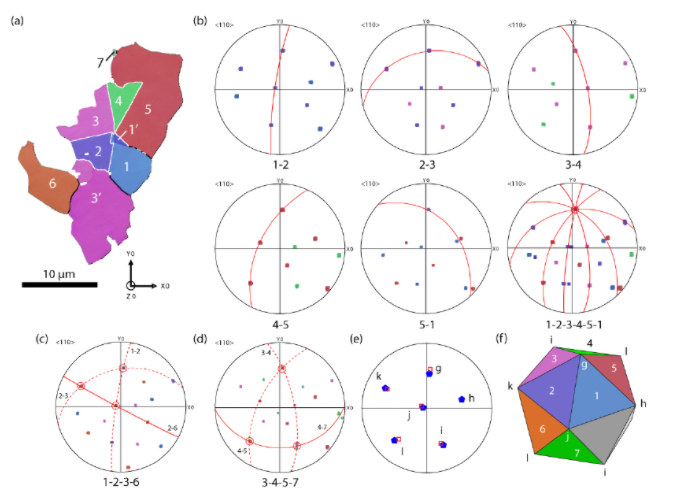Several aggregates of nearest-neighbour grains having multiple-twin orientation relationships (OR) have been found in the equiaxed zone. Figure 2(a) shows an assembly of grains in twinning orientation relationships, obtained from an high-resolution EBSD map, and labeled from 1 to 7. The h110ipole figures showing their mutual twin ori entations are given in Figure 2(b-d) where the red arc of a circle is the trace of their common {111}plane. Between each pair of grains in Figure 2(b), the common {111}plane is rotated by 70.5 deg. around a common h110idirection, which is indicated by the red circle where all the pole figures in (b) are superimposed. The pairs of grains 1-2, 2-3, 3-4,4-5 show perfect twin orientation relationships (OR). The orientation relationship between grains 5 and 1 correspond to what Kurtuldu et al. define as near-twin OR : a twin OR and a rotation of about 7 to 8 deg around a common h110idirection. This assembly of 5 grains is compatible with the symmetry of a decahedron with grains 1 and 5 that accommodate the default aperture angle of 7.5 deg. This rotation corresponds to the cumulated angle difference between 5 tetrahedra of the icosahedron (360 deg) and 5 regular {111}tetrahedra of the fcc structure (352.5 deg) .2 other grains were found to feature twinning OR with one of the 5 grains presented in the figure, and 4 additional (110), common to at least 3 grains, were found, as shown in Figure 2(c) and (d).



The grain labeled 6 displays a twin OR with grain 2 and share a common h110 iaxis with grain 1 and 3; the grain labeled 7 displays a twin OR with grain 4 and share a common h110 iaxis with grain 3 and 5. Grains 6 and 7 have a near-twin OR (not represented in the figure). The h110 ipole figure in Figure 2(e) shows the 5 common h110 idirections of the fcc grains, together with the calculated stereographic projection of the fivefold symmetry axes of the icosahedron. A perfect icosahedron is also shown in Figure 2(f) with facets that have given rise to the fcc grains with the same color and number in Figure 2(a). This confirms as in Al-based and Au-based alloys that ISRO-mediated nucleation mechanism applies for fcc Nickel in 718 alloy.
In Al-Zn and Au-Cu-Ag alloys, the occurence of ISRO in the liquid is induced by minute additions of Cr and Ir,respectively. Approximant phases exhibiting icosahedral building blocks have been found in the Al-Cr system as well as a few Au-rich Tsai-type icosahedral quasicrystals (i-QC), but there is no known Ni-rich i-QC. Also, no specific element has been added and the microstructures have been obtained in this work with a commercial Nickel alloy 718 wire. As shown by Zollinger et al.rapid processing of ISRO-containing alloys can lead to a spinodal-like decomposition of the liquid phase, leading to local heterogeneities in the liquid phase. The effect of ISRO on hetero geneous local ordering has also been evidence by ab-initio molecular dynamics simulations in Al-Zn-Cr. In the present work, the local heterogeneity leading to icosahedral clusters in the liquid may not be intrinsic, i.e. induced by a specific chemical element (such as Cr additions in Al-Zn alloys leading to Cr-centered icosahedra ), but induced by the rapid melting and solidification conditions inherent to AM processes. With heating rate in the general range of 1 to 8.104K/s , the n−1layer that partially remelt has little time for the ordered fcc phase to disordered liquid transition that could lead to partially disordered liquid or even metastable short-range order configurations including a certain fraction of ISRO. This hypothesis can be corroborated by an analysis based on the columnar-to-equiaxed transition (CET).

